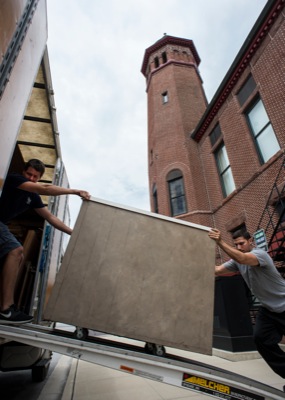Friday, July 17th, 2015
Celina voters likely to face school construction levy
State commission would pay for 46 percent of possible $77.2M project
By Jared Mauch
MINSTER - Celina City School district voters will likely be asked to help pay for new and consolidated buildings that could cost as much as $77.2 million.
School board members met Thursday with Garmann Miller & Associates representatives at the firm's Minster office for a work session to discuss renovating or replacing the district's seven buildings.
The discussion revolved around a set of four master plans created by Garmann Miller. A final master plan would be put to vote for city voters. The plans vary in price from $58.8 million to $77.2 million, not including demolition costs.
The Ohio School Facilities Commission has indicated it would pay for about 46 percent of the building costs.
"The first step is to make sure they will co-fund ..., what we want to do," Wayne Coleman of Garmann Miller said.
Option One
The first option would involve constructing an 86,192-square-foot elementary building for kindergartners through third-graders, estimated at $19.8 million.
The estimates are based on square footage and student population but do not account for specific features such as security systems or computers, Coleman said after the meeting.
The option includes adding 2,230 square feet to the intermediate school for fourth-grade classrooms at a cost of about $10 million.
Renovations to the middle school are budgeted for about $11.5 million and high school renovations would cost $27.8 million.
The three-story academic wing of the high school would be demolished and replaced with a one-story section. New classrooms would be built behind the current building, Coleman explained.
Estimated total cost of the option was $69.9 million with a local share of $38.4 million.
Option Two
The second option includes spending $26.1 million to construct a 121,795-square-foot building for kindergarten through fifth grade, according the Garmann Miller estimates.
The option also includes spending about $12.3 million to renovate and add 11,737 square feet to the intermediate school, which would house grades 6-8.
The plan includes making the same changes to the high school at a cost of $27.2 million.
That option's total cost was $65.8 million with a local share of $36.1 million.
Option Three
The third option includes spending $19 million to build an 86,192-square-foot elementary building for kindergarten through third grade, according the Garmann Miller estimates.
The option also includes spending $9.4 million to renovate and add 2,230 square feet to the intermediate school, which would house grades 4-6.
Renovations and adding 85,000 square feet to the high school, which would house grades 7-12, totaled about $30.2 million.
Estimated total cost of the third option was $58.8 million with a local share of $32.2 million.
Option Four
The final option would involve spending $19 million to build an 86,192-square-foot elementary building to house kindergarten through third grade.
The option also includes spending $9.9 million to renovate and add 2,230 square feet to the intermediate school, which would house grades 4-6.
A new high school of 205,045 square feet for grades 7-12 would cost about $48.1 million.
Estimated total cost of the option was $77.2 million with a local share of $42.4 million.
"Ultimately, what you're going to present to your voters is 'look at where our needs are for academic space. Look what we've been dealing with whether it's ceilings falling in or flooding.' Your buildings have served you well but they don't need to be 90 years old - that now they're out of date," Coleman said.
"You've got to vote and you've got to vote to take care of your schools and your family," board member Ken Fetters said.
Schools tell people a lot about a community, board president Connie Paulus added.
The two sides may meet again but the board must inform the OSFC of construction estimates.
"These options are just the first baby steps to options to get some of your feedback. We knew the numbers may move but we wanted to give you some kind of idea," Coleman said.
More options could be created to account for the education complex and the Head Start program, he added.
"There's just so much that we could incorporate it's just trying to get the right direction to go. That's the first step," Coleman said.
No action was taken from the two hours of discussions.



